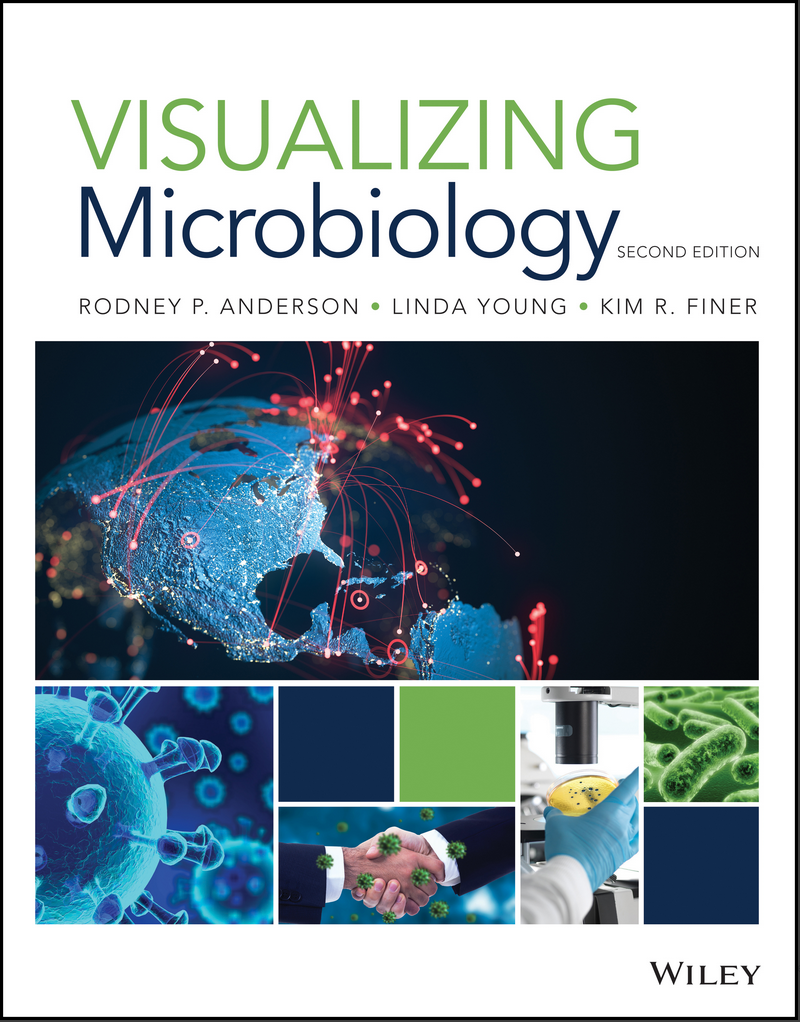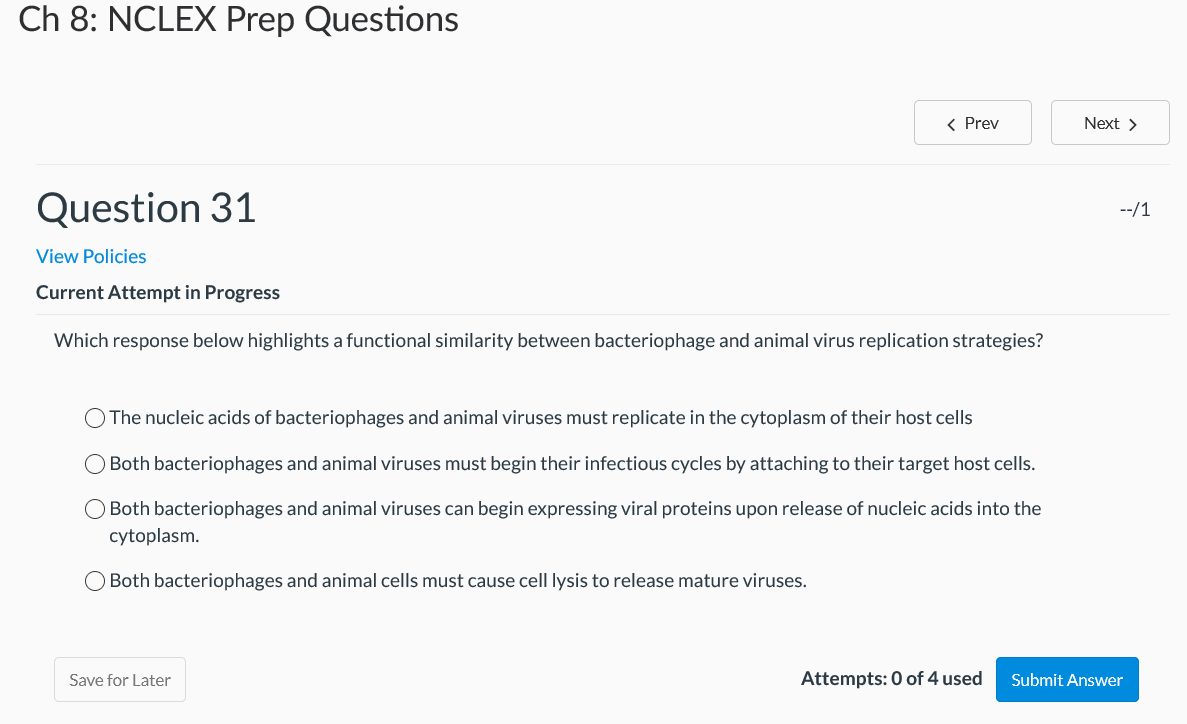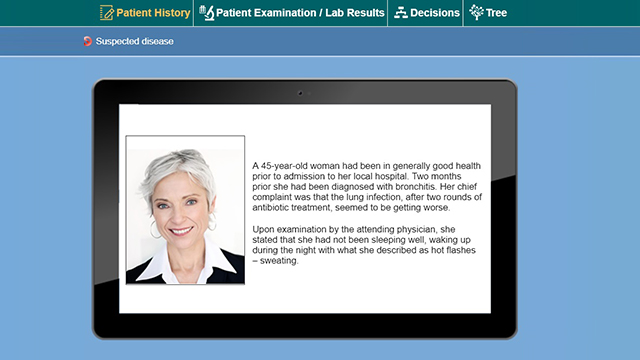
Visualizing Microbiology, 2nd Edition
By Rodney P. Anderson and Linda Young
Visualizing Microbiology combined with WileyPLUS provides students with the resources and practice necessary to engage in critical thinking and application of real-world content. The unique visual pedagogy of the text provides a powerful combination of content and visuals ideal for microbiology. Case studies written in a personal narrative format, supported by a comprehensive library of animations and videos, introduce students to microbiology through an engaging and customizable digital experience. Visualizing Microbiology also brings the narrative to life with an applied clinical focus, helping students see and understand the unseen in the world of microbiology.
Schedule a Demo Request Instructor AccountWant to learn more about WileyPLUS? Click Here

NCLEX Prep Questions
30 multiple‐choice questions that allow students to prepare for the NCLEX exam in relation to the chapter content.

Case Studies
Written in the personal narrative format shown to enhance long-term knowledge retention, case study patient scenarios frame each chapter. Students are exposed to medical scenarios that accurately simulate true patient/care provider interactions. These realistic experiences nurture critical thinking skills while also encouraging the development of patient empathy, improving comprehension of patient compliance problems and facilitating student understanding of transcultural health care concerns.
Microbiology Toolbox Videos
These videos of key experiments in microbiology include many classic and common clinical lab experiments along with more recent lab techniques. These videos expose students to the lab and allow them to see best practices and the application of techniques being learned.
Animations
Course materials includes a comprehensive library of animations designed to aid student learning and to provide faculty with the tools to bring core microbiology concepts into the classroom. Visualizing Microbiology students benefit from an animated learning system consisting of vibrant art, five to seven 3D animations that focus on the core topics of microbiology, and supplemental 2D animations which allow students to review and revisit the concepts from the course.
What’s New
Visualizing Microbiology-
- has been carefully revised to respond to user feedback and
- All material been revised with the most current data on incidence, treatment, and prevention of microbial diseases:
- Updated classification of bacteria and viruses included throughout.
- New Case Studies, Microbiology InSights, Clinical Applications, and What a Microbiologist Sees explore topics of current interest.
- Figures and tables revised to enhance their learning features and value as study tools.
- Two new chapters:
- Chapter 2, An Introduction to the Chemical Basis of Life, covers basic chemical concepts that will be essential for understanding later course material, including atomic structure, chemical interactions, the chemistry of water, pH, and essential carbon-based chemistry. This new chapter provides fundamental information for beginning undergraduate students and can also be used with more advanced students for a review of basic concepts.
- Chapter 5 from the first edition, Eukaryotic Organisms, is now two separate chapters, and coverage of both topics has been expanded. In the new edition, Chapter 6, The Eukaryotic Cell, presents information about the structure and function of eukaryotic cell components and the evolution of organisms in the eukaryotic domain. Chapter 7, Eukaryotic Organisms, provides an overview of eukaryotic microorganisms, highlighting those that are human pathogens.

Rodney P. Anderson received his Ph.D. in biological sciences from the University of Iowa in 1989. His doctoral work centered on protein synthesis mechanisms in E. coli. After graduate school, he began his academic career at Ohio Northern University where he continues to teach and conduct research with undergraduates in the Department of Biological and Allied Health Sciences. He teaches microbiology for majors and allied health students as well as courses in genetics. He has also introduced non-majors to microbiology through interdisciplinary seminars in disease and society.
Anderson has been actively involved in microbiology education. He was previously president of ASM’s Conference on Undergraduate Education, which developed the core curriculum for undergraduate microbiology courses, and has organized and spoken at education division symposia at ASM’s General Meeting. Outreach activities have included Microbial Discovery Workshops for high school science instructors as well as discovery science activities at local elementary schools. He is the author of two books published by ASM press: Outbreak and The Invisible ABCs.

Linda M. Young, since earning her Ph.D. in botany at Ohio State University (OSU) in 1988, has been teaching freshman and advanced-level biology courses at Ohio Northern University (ONU), a student-centered institution which emphasizes effective instruction as a faculty member’s principle responsibility. Throughout her tenure, Young has regularly directed student-based research projects and periodically collaborated with investigators at OSU. She served seven years as the assistant dean of the Getty College of Arts and Sciences, which gave her the opportunity to implement several programs to assist students experiencing academic difficulty, ease the transition of freshman into college, and support the endeavors of high-achieving students. Although initially educated as a plant/cell physiologist, changing departmental needs led to her retraining. Consequently, Young now also teaches microbiology for Allied Health Sciences (nursing) as well as introduction to microbiology (majors). Her research has also changed and now targets infection control issues and antibiosis. Young serves locally as a member of the Allen County MRSA Task Force and has previously authored the laboratory manual used for general botany at ONU.

Kim R. Finer received her Ph.D. in Veterinary Microbiology from Texas A&M University in 1984. Her doctoral work focused on microbe–host interactions of Bordetella avium in turkeys. She went on to complete a postdoctoral fellowship in Food Microbiology at North Carolina State University working with Lactobacilli spp. As Professor of Biological Sciences at Kent State University (KSU), she has taught a variety of courses including Basic (nursing) and General (majors) Microbiology, Virology, Human Genetics, HIV/AIDS, Science and Culture, and Principles of Infectious Disease. During her tenure at KSU, she received two campus teaching awards, three national teaching awards, and the KSU President’s Award of Recognition.
Dr. Finer’s activities in the American Society for Microbiology (ASM) include service as education division chair, member of the education committee, Region 3 branch division representative, member of the Committee on the Status of Women in Microbiology, and selection as a Waxman Lecturer. Dr. Finer has authored numerous textbook supplements and published a variety of teaching-centered research articles and case studies.
Chapter 1 – Microbial World
Chapter 2 – Introduction to the Chemical Basis of Life
Chapter 3 – The Biochemistry of Macromolecules
Chapter 4 – Microscopy
Chapter 5 – Prokaryotic Organisms
Chapter 6 – The Eukaryotic Cell
Chapter 7 – Eukaryotic Organisms
Chapter 8 – Viruses and Other Infectious Particles
Chapter 9 – Metabolism
Chapter 10 – Microbial Genetics and Genetic Engineering
Chapter 11 – Microbial Growth and Control
Chapter 12 – Antimicrobial Agents
Chapter 13 – Innate Immunity
Chapter 14 – Adaptive Immunity
Chapter 15 – Vaccination, Immunoassays, and Immune Disorders
Chapter 16 – Microbial Pathogenesis
Chapter 17 – Epidemiology and Infection Control
Chapter 18 – Diseases of the Respiratory System
Chapter 19 – Diseases of the Skin and Eyes
Chapter 20 – Diseases of the Gastrointestinal System
Chapter 21 – Diseases of the Urogenital System
Chapter 22 – Diseases of the Nervous System
Chapter 23 – Diseases of the Cardiovascular and Lymphatic System
Chapter 24 – Environmental and Industrial Microbiology

